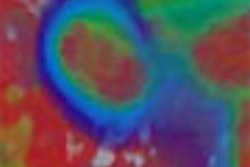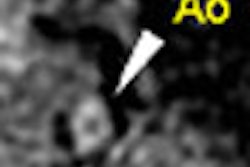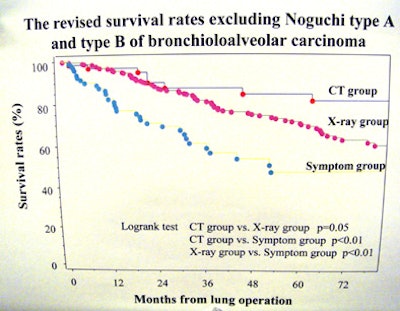
SAN FRANCISCO - A lung cancer screening study of nearly 20,000 subjects in Japan found smaller tumors and improved survival rates with CT. Another study, from Oklahoma City, confirmed that CT-detected lung nodules that were stable over two years' time would remain benign.
CT screening
In decades past, lung cancer screening trials using x-ray and sputum cytology have failed to show a mortality benefit. Similarly, CT screening -- despite numerous studies concluding that it finds smaller, earlier-stage cancers compared to other detection methods -- has not demonstrated a conclusive mortality reduction. To do so would require, among other things, a control group of patients who were not screened, and studies are under way. In the meanwhile, estimates of reduced mortality constitute another kind of evidence.
The retrospective study from Nagano, Japan, estimated the efficacy of chest CT for lung cancer screening by analyzing the prognoses and clinical features of the lung cancers that were detected and resected between 1996 and 2006. The group confirmed and resected 783 lung cancers during the study period, including 149 detected by CT screening, 341 by x-ray screening, and 113 in patients with symptoms suggestive of lung cancer.
CT showed an "an impressive clinical utility," the researchers reported. CT-screened patients had smaller tumors compared to other cohorts, and demonstrated substantially better survival even if cancers with the most favorable expected outcomes were excluded.
"We diagnose most lung cancers with bronchoscopy," but opted for surgery in 33 patients with suspected bronchoalveolar cell carcinoma (BAC), lead investigator Dr. Kiochi Kondo told AuntMinnie.com at this week's 2007 American Thoracic Society (ATS) meeting. "Sometimes BAC is very difficult to diagnose using bronchoscopy and wedge resection," he said.
Chest CT screening isn't reserved for long-term smokers in Japan, and in fact nearly half of all cancers diagnosed in the study were from nonsmoking patients, Kondo said.
Previous studies have shown that lung cancer cases among Japanese who have never smoked (approximately 70% of women and 9% men diagnosed) are higher than in comparable U.S. populations (9% to 13% of women and 2% of men).
The risk among nonsmokers appears to be inherited. A study of more than 102,000 Japanese men and women found that having a parent or sibling with lung cancer doubles a person's risk of lung cancer, and that the risk of inherited lung cancer is greater for women (2.65-fold risk) than for men (1.69-fold risk) (Chest, October 2006, Vol. 130:4, pp. 968-975). Researchers have identified several mutations in the epidermal growth factor receptor (EGFR) genes that are common in the lung tumors of nonsmokers. Current research is aimed at identifying the mechanisms of expression and developing EGFR inhibitors.
Kondo and his team examined the clinical features of patients who were diagnosed by CT screening and underwent surgery. Bronchoalveolar cell carcinomas (Noguchi types A and B), the histologies with the most favorable expected outcomes, constituted 48% of the total histological types diagnosed by CT, 6.5% of the x-ray-detected group, and 3.5% of the symptomatic group, Kondo said.
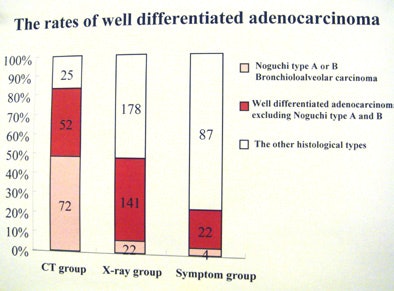 |
| All data courtesy of Dr. Kiochi Kondo. |
Demographics for the three groups were similar for age: 64.5 ± 8.8., 66.9 ± 9.8, and 65.5 ± 10.1 for the CT, x-ray, and symptom groups, respectively; and gender: 77 males and 72 females for CT, 191 males and 150 females for x-ray, and 81 males and 32 females for the symptomatic group.
The five-year survival rates were 93% in the CT group, 72% in the x-ray group, and 50% in the symptom group. However, because so many of the CT-detected cancers were BAC, which has a favorable prognosis, the researchers sought to level the mortality playing field a bit by excluding patients with BAC from the analysis, yielding revised five-year survival rates of 85%, 71% ,and 45% for the CT, x-ray, and symptomatic groups, respectively. So even excluding BACs, Kondo said, CT still yielded the best overall survival among the three groups.
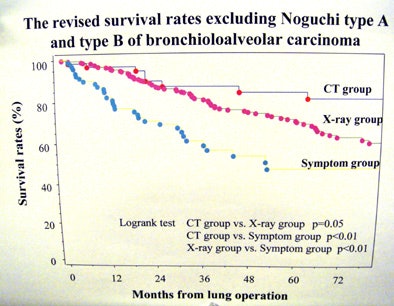 |
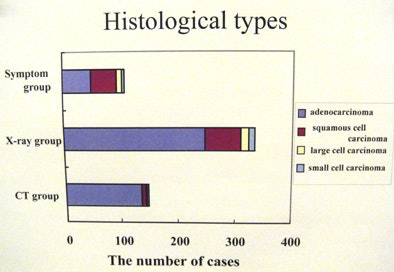 |
The researchers found other differences among the patient groups. Tumor size in the CT group (mean 14 mm) was significantly smaller than for the x-ray group (mean 30 mm) or symptom group (mean 42 mm). X-ray and CT cancers were both better differentiated than the symptomatic cancers. Preoperative serum carcinoembryonic antigen (CEA) values, and the proportion of squamous cell carcinomas to all cancers, were highest in the symptomatic group.
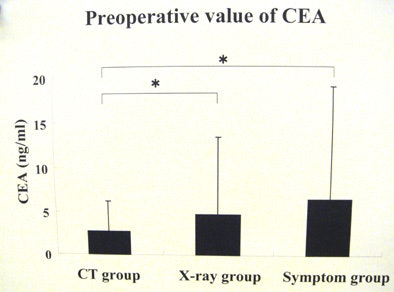 |
The postoperative prognoses of patients diagnosed by CT screening were excellent compared to other methods, even when BACs were excluded, Kondo said, concluding that CT lung cancer screening contributes greatly to results of lung cancer resection.
CT-detected stable pulmonary nodules
Another poster, from Oklahoma City, examined the widely accepted notion that that a CT-detected solitary pulmonary nodule (SPN) that remains stable for two years is benign. Dr. Nadine Daher and her team from the University of Oklahoma Medical Center examined 29 stable nodules in 27 patients with a mean 51 pack years of smoking.
The lesions ranged in size from 0.5 cm to 4.5 cm (mean 1.7 ± 0.9 cm), with most occurring in the right upper (38%) and left upper (24%) lobes. The patients were re-examined at a mean 1.5 ± 1.4 years with chest x-ray (n = 10) or CT (n = 16), or in one case both.
Only one of the 29 nodules (3.4%) grew from 2.4 to 3 cm, with a doubling time of 1,719 days, suggesting a benign etiology, the authors wrote in their abstract. And 26 of the 29 patients are still alive 2.2 years after the two-year stability period. The expectation of benignity once a nodule has been stable for two years appears to hold true, they concluded.
By Eric Barnes
AuntMinnie.com staff writer
May 24, 2007
Related Reading
Molecular imaging tracks lung cancer therapy response, May 22, 2007
Low-dose CT practical for lung cancer screening, April 30, 2007
Divergent research on CT lung screening sparks more debate, fewer answers, April 19, 2007
CT screening may not improve lung cancer survival, March 7, 2007
Italung-CT results show efficacy of lung cancer screening, March 9, 2007
Copyright © 2007 AuntMinnie.com






